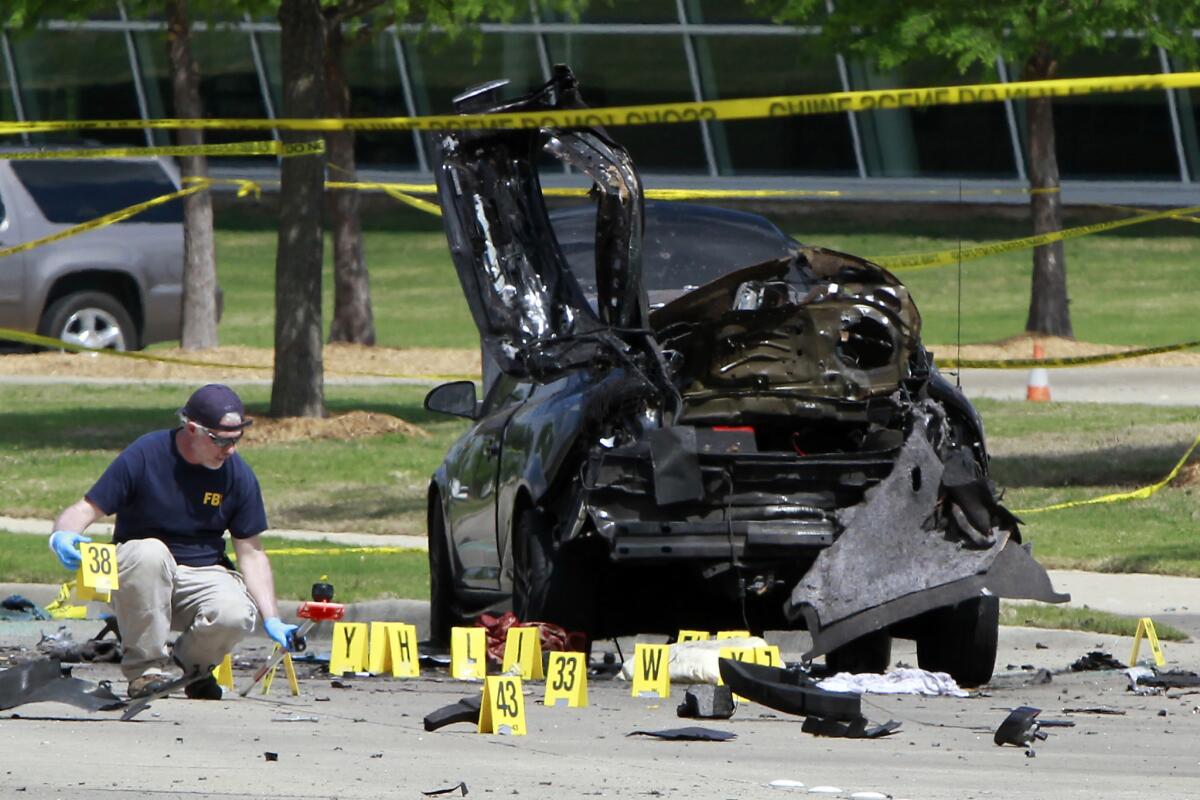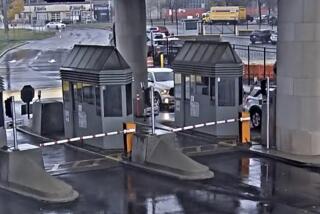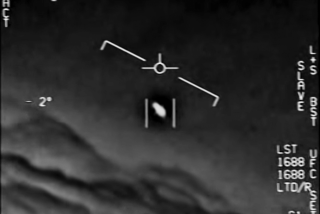U.S. response to terrorism is weakened by lapses in communication

Members of the FBI Evidence Response Team investigate the crime scene outside of the Curtis Culwell Center on May 4, 2015, after a shooting in Garland, Texas.
When FBI agents realized Elton Simpson had slipped away from his north Phoenix apartment last month, they immediately became concerned. Their worries grew when they learned after he vanished that he had been surfing the Internet using the hashtag “attacktexas.”
According to FBI Director James Comey and other top federal officials, the bureau immediately warned Garland, Texas, police that the avowed jihadist, inspired by Islamic State militants, might be headed there to attack a cartoon contest designed to mock the prophet Muhammad.
But local law enforcement officials in Garland, including the police chief, insist they were never warned and that only with the luck of some quick-acting officers managed to stop Simpson and an accomplice from storming the event with assault rifles and hundreds of rounds of ammunition.
Both men were shot dead, and a terrorist attack was averted.
Left unanswered from that May 3 confrontation and the subsequent finger-pointing are questions raised years earlier by the 9/11 Commission and at numerous hearings on Capitol Hill: Are federal and police agencies doing enough to share intelligence information with each other and cooperating to keep the country safe from terrorism?
The commission concluded that a key failure in stopping the 9/11 hijackers was rooted in the resistance by intelligence and law enforcement agencies to trade crucial information. Weeks after the terrorist attacks, a communications lapse between federal and local agencies was blamed by some lawmakers for slowing the response to the 2001 anthrax attacks.
“The biggest impediment,” the commission warned, “is the human or systemic resistance to sharing information.” Intelligence “should be processed, turned into reports and distributed according to the same quality standards, whether it is collected in Pakistan or in Texas.”
In response to 9/11, officials created Joint Terrorism Task Forces around the country, where federal, county and city police work together to gather, analyze and act on intelligence.
The Garland case has emerged as one of the biggest tests of that system, and although the attack was foiled it revealed that communication lapses and distrust continue to complicate the fight against terrorism.
The FBI maintains it alerted the Garland police representative on the Dallas-area joint task force about Simpson and suggested the cartoon convention might be at risk.
“We developed information just hours before the event that Simpson might be interested in going to Garland,” Comey said at a May 7 news briefing.
He said the FBI quickly issued a bulletin to the Garland police warning them that Simpson or his accomplice, Nadir Soofi, might show up there.
But Garland police say they never received an immediate warning from the FBI and that their task force also was not alerted. Garland police Chief Mitch Bates said reports that his department received word that an attack might be imminent “are not accurate.”
“No one,” the chief said. “Not the Garland Police Department, the FBI, the Texas Department of Public Safety, nor any other agency had the information prior to the event that either suspect may target this event. No information was missed or ignored.”
Bates said an FBI bulletin was issued two days earlier, on May 1. But he said it indicated “no known, credible threats” and simply said “what we already knew: that the event was a potential target.”
He added, “the identities of the two suspects were not known to us until many hours after the shooting.”
The questions of who knew what and when, and whom they told, loom large, as does the issue of how the FBI lost track of Simpson. According to FBI officials, federal agents are working 100 or more active terrorism investigations and do not have the manpower or equipment to provide 24-hour surveillance on all of them.
Federal officials say the threat of “lone wolf” attacks like the one in Texas is only growing.
Comey and others pointed to the explosion of social media that makes it easier for foreign terrorist groups to recruit jihadists in this country. “I know there are other Elton Simpsons out there,” the director said.
Michael B. Steinbach, the FBI’s assistant director for its Counterterrorism Division, testified at a June 3 House Homeland Security Committee hearing that about 200 Americans had traveled to Syria or tried to reach that region to join Islamic State. All of them, he said, “potentially pose a significant threat to the safety of the United States.”
To combat that growing threat, federal agents are hosting training exercises with community leaders to heighten public awareness of suspicious activity, said John Mulligan, deputy director of the National Counterterrorism Center, during the hearing. “We need to effectively engage it before it manifests in violence.”
Francis Taylor, undersecretary for intelligence and analysis at the Department of Homeland Security, acknowledged at the hearing that the Garland incident had “reinforced the importance of close collaboration and information-sharing.”
For instance, Taylor said, authorities enhanced their information-sharing when they became aware in late May of a planned rally where anti-Muslim protesters, many carrying weapons, gathered outside a Phoenix mosque. Taylor said police security was beefed up and, at the urging of federal officials, officers spoke with community and faith leaders to gauge the threat level.
Taylor said it was all done “in real time to help ensure local leadership and law enforcement have the necessary information to protect their communities and cities.”
Better cooperation between local and federal agencies weighed heavily in Boston last week, when a knife-wielding man who wanted to behead police officers was slain during a confrontation with an FBI agent and a Boston police officer.
Members of the local joint task force in Boston, including FBI agents and state and city police officers, were tracking the man for several weeks, and moved in on him when he purchased three large knives and began discussing plans to behead police officers.
In the end, a two-man team — comprised of a federal agent and a city police officer — worked together in confronting him. They fatally shot him when he reportedly threatened them with one of the knives.
Rep. Bennie Thompson of Mississippi, the top Democrat on the Homeland Security panel, said no one can say whether the Garland incident would have had a different outcome — without a gun battle — had the FBI bulletin gotten through.
“But I do think this illustrates we need to continue looking into information-sharing,” he said, “and listening to the boots on the ground on how to recognize and prevent acts of homegrown violent extremism.”
richard.serrano@latimes.com
Twitter: @RickSerranoLAT
More to Read
Start your day right
Sign up for Essential California for news, features and recommendations from the L.A. Times and beyond in your inbox six days a week.
You may occasionally receive promotional content from the Los Angeles Times.







